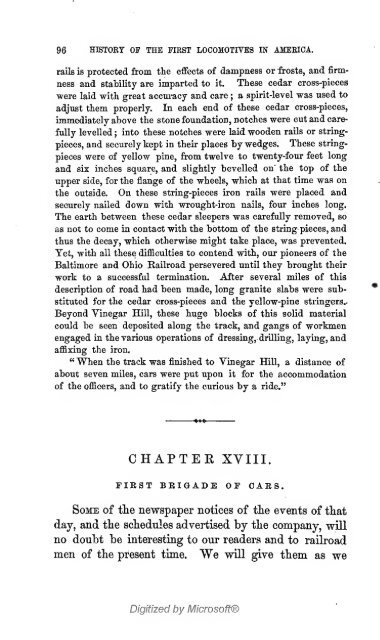The history of the first locomotives in America. From original ...
The history of the first locomotives in America. From original ...
The history of the first locomotives in America. From original ...
You also want an ePaper? Increase the reach of your titles
YUMPU automatically turns print PDFs into web optimized ePapers that Google loves.
96<br />
HISTOKT OF THE FIRST LOCOMOTIVES IN AMERICA.<br />
rails is protected from <strong>the</strong> effects <strong>of</strong> dampness or frosts, and firm-<br />
ness and stability are imparted to it. Tkese cedar cross-pieces<br />
were laid with great accuracy and care ;<br />
a spirit-level was used to<br />
adjust <strong>the</strong>m properly. In each end <strong>of</strong> <strong>the</strong>se cedar cross-pieces,<br />
immediately above <strong>the</strong> stone foundation, notches were cut and care-<br />
fully levelled ; <strong>in</strong>to <strong>the</strong>se notches were laid wooden rails or str<strong>in</strong>g-<br />
pieces, and securely kept <strong>in</strong> <strong>the</strong>ir places by wedges. <strong>The</strong>se str<strong>in</strong>g-<br />
pieces were <strong>of</strong> yellow p<strong>in</strong>e, from twelve to twenty-four feet long<br />
and six <strong>in</strong>ches square, and slightly bevelled on' <strong>the</strong> top <strong>of</strong> <strong>the</strong><br />
upper side, for <strong>the</strong> flange <strong>of</strong> <strong>the</strong> wheels, which at that time was on<br />
<strong>the</strong> outside. On <strong>the</strong>se str<strong>in</strong>g-pieces iron rails were placed and<br />
securely nailed down with wrought-iron nails, four <strong>in</strong>ches long.<br />
<strong>The</strong> earth between <strong>the</strong>se cedar sleepers was carefully removed, so<br />
as not to come <strong>in</strong> contact with <strong>the</strong> bottom <strong>of</strong> <strong>the</strong> str<strong>in</strong>g- pieces, and<br />
thus <strong>the</strong> decay, which o<strong>the</strong>rwise might take place, was prevented.<br />
Yet, with all <strong>the</strong>se difficulties to contend with, our pioneers <strong>of</strong> <strong>the</strong><br />
Baltimore and Ohio Railroad persevered until <strong>the</strong>y brought <strong>the</strong>ir<br />
work to a successful term<strong>in</strong>ation. After several miles <strong>of</strong> this<br />
description <strong>of</strong> road had been made, long granite slabs were sub-<br />
stituted for <strong>the</strong> cedar cross-pieces and <strong>the</strong> yellow-p<strong>in</strong>e str<strong>in</strong>gers..<br />
Beyond V<strong>in</strong>egar Hill, <strong>the</strong>se huge blocks <strong>of</strong> this solid material<br />
could be seen deposited along <strong>the</strong> track, and gangs <strong>of</strong> workmen<br />
engaged <strong>in</strong> <strong>the</strong> various operations <strong>of</strong> dress<strong>in</strong>g, drill<strong>in</strong>g, lay<strong>in</strong>g, and<br />
affix<strong>in</strong>g <strong>the</strong> iron.<br />
" When <strong>the</strong> track was f<strong>in</strong>ished to V<strong>in</strong>egar Hill, a distance <strong>of</strong><br />
about seven miles, cars were put upon it for <strong>the</strong> accommodation<br />
<strong>of</strong> <strong>the</strong> <strong>of</strong>ficers, and to gratify <strong>the</strong> curious by a ride."<br />
CHAPTEE XVIII.<br />
riEST BEIGADE OF CARS.<br />
Some <strong>of</strong> tlie newspaper notices <strong>of</strong> tlie events <strong>of</strong> tliat<br />
day, and <strong>the</strong> schedules advertised by <strong>the</strong> company, will<br />
no doubt be <strong>in</strong>terest<strong>in</strong>g to our readers and to railroad<br />
men <strong>of</strong> <strong>the</strong> present time. We will give <strong>the</strong>m as we<br />
Digitized by Micros<strong>of</strong>t®
















